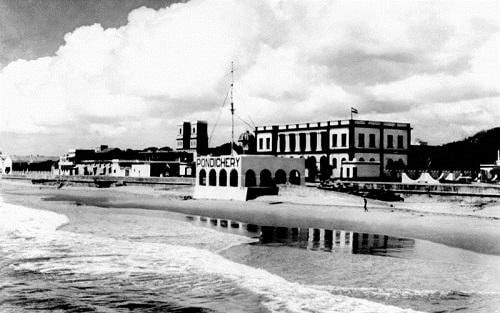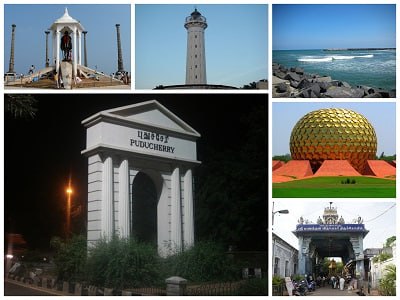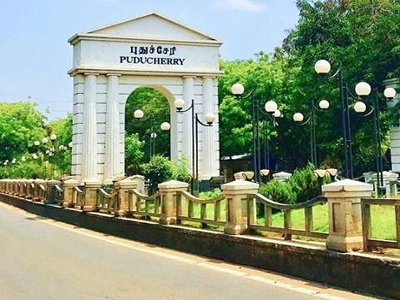History of Puducherry

Pre-Colonial Period
Puducherry’s history dates back to ancient times, with evidence of human activity as early as the 3rd or 2nd century BCE. The region was a significant trading hub known as “Poduke” or “Poduca,” mentioned in the Periplus of the Erythraean Sea, a 1st-century Roman text. Archaeological excavations at Arikamedu, 7 km south of modern Puducherry, reveal Roman trade in dyed textiles, pottery, and semi-precious stones, indicating its role as a port town. Scholars suggest Puducherry was also called Vedapuri, meaning “abode of Vedic knowledge,” due to its association with learned scholars and possibly a Sanskrit university, as hinted by the 8th-century Bahur Plates. Legend ties the area to Sage Agastya, who is said to have established an ashram here, lending it the name Agastiswaram.
From the 4th century CE, Puducherry was part of various South Indian dynasties:
- Pallava Kingdom (325–900 CE): Ruled from Kanchipuram, marking the early medieval period.
- Chola Dynasty (900–1279 CE): Took over, enhancing regional trade and culture.
- Pandya Dynasty (1279–1370 CE): Succeeded the Cholas, continuing the area’s prominence.
- Vijayanagara Empire (1370–1614 CE): Controlled the region under the Naikship of Gingee.
- Sultanate of Bijapur (1614–1638 CE): Briefly ruled before European influence grew.
Colonial Period
The colonial history of Puducherry began with the arrival of European powers:
- Portuguese (1521): Established a factory for textile trade, marking the first European presence.
- Dutch and Danes (17th century): Set up trading posts, with the Dutch later active in nearby Porto Novo and Cuddalore.
- French (1674): The French East India Company, under François Martin, founded a settlement on February 4, 1673, after acquiring a firman from the Qiladar of Valikondapuram under the Sultan of Bijapur. Martin transformed the fishing village into a flourishing port town. The French faced challenges, losing Puducherry to the Dutch in 1693, but regained it in 1699 via the Treaty of Ryswick. They later acquired Mahe (1720), Yanam (1731), and Karaikal (1738).
Anglo-French Rivalry (1742–1814): Puducherry changed hands multiple times during the Anglo-French wars. The British captured it in 1761, returning it in 1763 via the Treaty of Paris. It was occupied again by the British in 1793 during the French Revolution, restored to France in 1814, and remained under French control until 1954.
Transition to Indian Union
After India’s independence in 1947, negotiations began to integrate French territories. A referendum in 1948 allowed residents to choose their future, and on November 1, 1954, Puducherry and its enclaves (Karaikal, Mahe, Yanam) were transferred de facto to India. The de jure transfer occurred on August 16, 1962, formalized by the 14th Amendment to the Indian Constitution in 1963, making Puducherry a Union Territory. Chandernagore, another French enclave, merged with West Bengal instead.
Name Change
Originally called Putucceri (Tamil for “new village”), the French adapted it to Pondichéry. The British anglicized it to Pondicherry. On October 1, 2006, it officially reverted to Puducherry, reflecting its Tamil roots.

Complete Details About Puducherry City
Geography
- Location: Southeastern coast of India, 160 km south of Chennai, on the Coromandel Coast along the Bay of Bengal. It’s an enclave surrounded by Tamil Nadu, with a total area of 293 km² (part of the Union Territory’s 483 km²).
- Topography: Flat terrain with an average elevation of 15 meters above sea level, intersected by rivers like Gingee and Pennaiyar. The “Red Hills” (Gorimedu), 30 meters high, are a notable feature northwest of the city.
- Climate: Semi-arid, with temperatures averaging 30°C and humidity of 70–85%. Rainfall primarily comes from the Northeast Monsoon (October–December).
Demographics (2011 Census)
- Population: 244,377 in Puducherry city; 1,244,464 in the Union Territory.
- Gender Ratio: 124,947 females, 119,430 males (city); 50% male/female split in the district.
- Literacy Rate: 80.6% (84.6% male, 76.7% female).
- Languages: Tamil (predominant), French, English, Telugu, Malayalam. A small French-speaking community persists, including Tamil residents with French citizenship.
Administration
- Status: Capital of the Union Territory of Puducherry, which includes four districts: Puducherry, Karaikal, Mahe, and Yanam.
- Governance: Administered by the Government of India, with a Lieutenant Governor and an elected Legislative Assembly. The city has two municipalities: Puducherry and Uzhavarkarai.
- Historical Legacy: French administrative structures, like the 1880 decree establishing municipal councils, influenced early governance. The Pondicherry Municipalities Act, 1973, modernized local administration.
Economy
- Agriculture: Rice, sugarcane, cotton, peanuts; 24.37% of the population engaged in agriculture and allied activities, with 90% of cultivated land irrigated via tanks and tube wells.
- Fisheries: 45 km coastline supports 27 marine and 23 inland fishing villages, with a population of 65,000, including 13,000 active fishermen.
- Industries: Food processing, electrical appliances, textiles, paper, lumber. No heavy industries or mining; power is sourced from neighboring states (396.58 MW total).
- Tourism: A major driver, with attractions like beaches, colonial architecture, and spiritual sites.
Culture and Heritage
- French Influence: Known as the “French Riviera of the East,” Puducherry retains colonial architecture in the French Quarter (White Town), with cobblestone streets, yellow houses, and institutions like the French Consulate and Alliance Française.
- Spiritual Significance: Home to the Sri Aurobindo Ashram (founded 1926) and Auroville (1968), an experimental township promoting human unity, drawing global visitors.
- Festivals: Liberation Day (November 1), De Jure Transfer Day (August 16), and local Tamil festivals blend with French cultural events.
Key Attractions
- Beaches: Promenade (protected by a 2-km seawall), Paradise, Serenity, Auroville Beach.
- Historical Sites: Arikamedu (Roman trade site), Puducherry Museum (Roman artifacts), French colonial buildings.
- Religious Sites: Manakula Vinayagar Temple, Vedhapureeswarar Temple, Basilica of the Sacred Heart of Jesus, Notre Dame des Anges.
- Others: Botanical Garden, Chunnambar backwaters, Matrimandir (Auroville).
Connectivity
- Air: Puducherry Airport offers daily flights to Bengaluru (except Wednesdays); Chennai (151 km) and Trichy (203 km) airports are nearby.
- Rail: Connected to Villupuram (38 km), with daily trains to Chennai, Tirupati, and weekly services to Mumbai, Bangalore, Kolkata, etc.
- Road: Excellent bus connectivity to Chennai (3.5 hours), Bangalore, and Tamil Nadu towns via National Highways.
